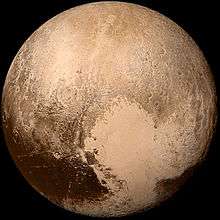(84922) 2003 VS2
|
| |
| Discovery[1] | |
|---|---|
| Discovered by | NEAT (644) |
| Discovery date | 14 November 2003[2] |
| Designations | |
| MPC designation | (84922) 2003 VS2 |
| none | |
| Plutino[3][4] | |
| Orbital characteristics[2][3] | |
| Epoch 13 January 2016 (JD 2457400.5) | |
| Uncertainty parameter 3 | |
| Observation arc | 8830 days (24.18 yr) |
| Aphelion | 42.413 AU (6.3449 Tm) |
| Perihelion | 36.456 AU (5.4537 Tm) |
| 39.435 AU (5.8994 Tm) | |
| Eccentricity | 0.075539 |
| 247.64 yr (90451.3 d) | |
Average orbital speed | 4.75 km/s |
| 15.535° | |
| 0° 0m 14.328s / day | |
| Inclination | 14.777° |
| 302.792° | |
| 114.317° | |
| Earth MOID | 35.4949 AU (5.30996 Tm) |
| Jupiter MOID | 31.5882 AU (4.72553 Tm) |
| Physical characteristics | |
| Dimensions |
523.0+35.1 −34.4 km[5] |
| 7.42 h (0.309 d) | |
Sidereal rotation period | 7.41±0.02 h[6] |
|
0.147+0.063 −0.043[5] | |
| Temperature | ≈44 K |
|
(moderately red) B−V= 0.93±0.02 V−R= 0.59±0.02[5] | |
| 19.7[7] | |
|
4.10±0.38,[5] 4.4[8] 4.73±0.02[9] 4.2[2] | |
(84922) 2003 VS2 is a trans-Neptunian object discovered by the Near Earth Asteroid Tracking program on November 14, 2003.[1] Like Pluto, it is in a 2:3 orbital resonance with Neptune,[3][4] giving it the orbital properties of a plutino. Mike Brown's website lists it as highly likely a dwarf planet.[10] However, Brown assumed that VS2 was much bigger than it really is, and the light-curve analysis has questioned whether it would truly be in the hydrostatic equilibrium.[11]
Orbit and rotation
Like Pluto, (84922) 2003 VS2 is locked in the 3:2 mean-motion resonance with Neptune, although its orbit is significantly less eccentric than Pluto's. It also has slightly smaller orbital inclination.[2]
(84922) 2003 VS2 has a significant light-curve amplitude of 0.21±0.01. The most likely value of the rotation period is 7.41±0.02 h.[6]
Physical characteristics
(84922) 2003 VS2 has a moderately red surface with a moderately red color indexes B−V=0.93, V−R=0.59.[9] Its geometrical albedo is about 15%.[5]
In 2007, its diameter was initially estimated by the Spitzer Space Telescope at 725±200 km.[8] However, in 2012, this was reduced to 523.0+35.1
−34.4 km after new Herschel Space Telescope observations.[5] The latter measurement is considered more reliable. Assuming a Pluto-like density of 2 g/cm3, one can obtain a mass estimate of about 1.5×1020 kg.
References
- 1 2 Marsden, Brian G. (2003-11-16). "MPEC 2003-W02 : 2003 VS2". IAU Minor Planet Center. Harvard-Smithsonian Center for Astrophysics. Retrieved 2010-01-06.
- 1 2 3 4 "JPL Small-Body Database Browser: 84922 (2003 VS2)" (2008-02-05 last obs). Retrieved 7 April 2016.
- 1 2 3 Buie, Marc W. (2008-02-05). "Orbit Fit and Astrometric record for 84922". SwRI (Space Science Department). Retrieved 2008-07-23.
- 1 2 "MPEC 2006-X45 : Distant Minor Planets". Minor Planet Center & Tamkin Foundation Computer Network. 2006-12-21. Archived from the original on 28 August 2008. Retrieved 2008-07-23.
- 1 2 3 4 5 6 Mommert, Michael; Harris, A. W.; Kiss, C.; Pál, A.; Santos-Sanz, P.; Stansberry, J.; Delsanti, A.; Vilenius, E.; Müller, T. G.; Peixinho, N.; Lellouch, E.; Szalai, N.; Henry, F.; Duffard, R.; Fornasier, S.; Hartogh, P.; Mueller, M.; Ortiz, J. L.; Protopapa, S.; Rengel, M.; Thirouin, A. (May 2012). "TNOs are cool: A survey of the trans-Neptunian region—V. Physical characterization of 18 Plutinos using Herschel-PACS observations". Astronomy & Astrophysics. 541: A93. arXiv:1202.3657
 . Bibcode:2012A&A...541A..93M. doi:10.1051/0004-6361/201118562.
. Bibcode:2012A&A...541A..93M. doi:10.1051/0004-6361/201118562. - 1 2 Sheppard, Scott S. (August 2007). "Light Curves of Dwarf Plutonian Planets and other Large Kuiper Belt Objects: Their Rotations, Phase Functions, and Absolute Magnitudes". The Astronomical Journal. 134 (2): 787–798. arXiv:0704.1636
 . Bibcode:2007AJ....134..787S. doi:10.1086/519072.
. Bibcode:2007AJ....134..787S. doi:10.1086/519072. - ↑ "AstDys (84922) 2003VS2 Ephemerides". Department of Mathematics, University of Pisa, Italy. Retrieved 2009-12-07.
- 1 2 Stansberry, John; Grundy, Will; Brown, Mike; Cruikshank, Dale; Spencer, John; Trilling, David; Margot, Jean-Luc (2008). "Physical Properties of Kuiper Belt and Centaur Objects: Constraints from Spitzer Space Telescope". In Barucci, M. Antonietta; Boehnhardt, Hermann; Cruikshank, Dale P. The Solar System Beyond Neptune (pdf). University of Arizona press. pp. 161–179. arXiv:astro-ph/0702538
 . ISBN 0-8165-2755-5.
. ISBN 0-8165-2755-5. - 1 2 Tegler, Stephen C. (2007-02-01). "Kuiper Belt Object Magnitudes and Surface Colors". Retrieved 2009-12-30.
- ↑ Brown, Michael E. "How many dwarf planets are there in the outer solar system? (updates daily)". California Institute of Technology. Retrieved 31 August 2016.
- ↑ Tancredi, Gonzalo (2009). "Physical and dynamical characteristics of icy "dwarf planets" (plutoids)". Proceedings of the International Astronomical Union Symposium S263. 5: 173–185. Bibcode:2010IAUS..263..173T. doi:10.1017/S1743921310001717. (Dwarf Planet & Plutoid Headquarters)
External links
- Orbital simulation from JPL (Java) / Ephemeris
- Huge rock-ice body circles Sun (Palomar Photo)
- 2003 VS2 precovery (18 Nov. '03 Major News about Minor Objects)
- (84922) 2003 VS2 at the JPL Small-Body Database


_(cropped).jpg)
